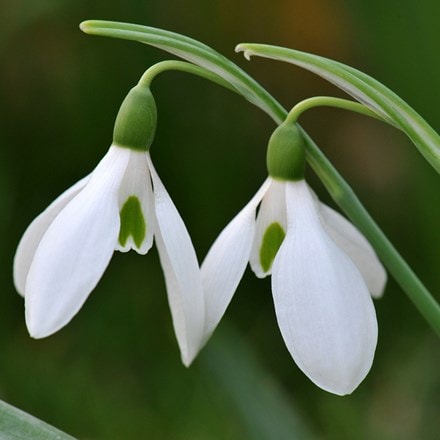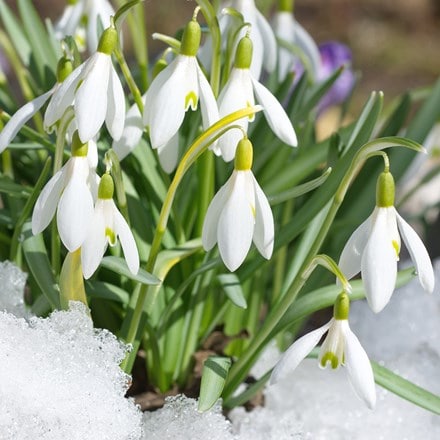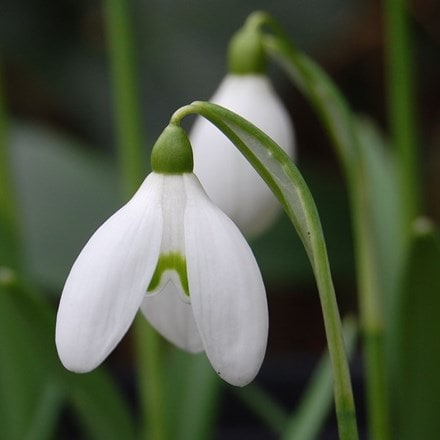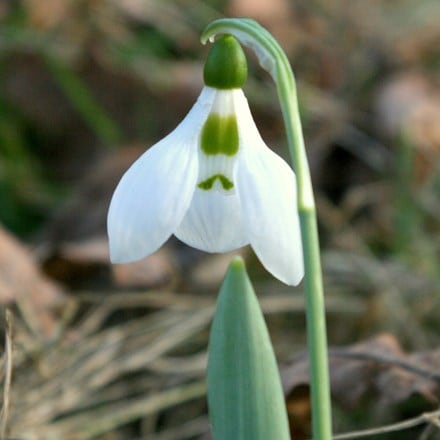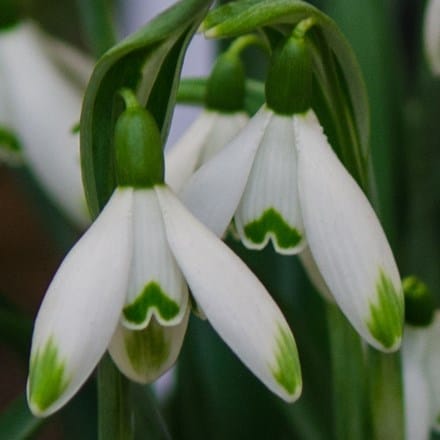When to plant snowdrop bulbs - tips for successful growing
The graceful nodding white flowers of the common snowdrop (Galanthus nivalis) are always a welcome sight in the garden. Emerging early in the year from their winter slumbers, they're often the first sign of the garden awakening for another year.
Besides the familiar bell-shaped blooms of the common snowdrop, there are a huge range of other varieties. From the double pear-shaped flowers of Galanthus nivalis f. pleniflorus 'Flore Pleno' to the large honey-scented Galanthus 'S. Arnott', snowdrops are a real favourite for collectors.
These much-loved flowering plants are easy to establish as long as you start them off on the right foot. In this simple grow guide we'll look at the best time to plant snowdrop bulbs and how to cultivate them successfully.


When to plant snowdrop bulbs
The ideal time to plant snowdrop bulbs is during the autumn season, usually between September and November. Planting in autumn allows the bulbs sufficient time to lay down root systems before the cold winter sets in. Snowdrops with strong, well-established roots will be better equipped to produce a healthy flush of blooms when spring arrives.
Quick tip: some gardeners prefer to plant snowdrops 'in the green', rather than using dry snowdrop bulbs. This is best done right after flowering in February and March while the foliage is still green.
How to plant snowdrop bulbs - step by step
Growing snowdrops from bulbs is simple but a little preparation and care will yield better results. Here are some simple tips to help you enjoy a stunning show of these dainty beauties:
1. Location and soil preparation
Snowdrops are woodland natives, so choose an area of the garden that receives partial shade or preferably dappled shade. In keeping with their origins, snowdrops prefer moist but well-drained soil. Before planting, loosen the soil and remove any weeds, stones and debris to create a healthy growing environment. Digging in garden compost or leaf mould will help the soil retain water.
You can also grow snowdrop bulbs in pots or containers filled with a well-draining multi-purpose compost. Or, if you wanted to try something different, snowdrops will thrive in a rock garden tucked in between boulders. The rock garden at RHS Wisley is a beautiful example, with delicate white drifts that resemble a snow-dusted mountain top.
2. Buying your bulbs
Don't buy snowdrop bulbs too early - ideally wait until your soil is prepared or you have your pot and compost ready. It's best to plant the bulbs immediately after they arrive, as they dry out quickly which can compromise their growth.
At Crocus, we ensure your bulbs arrive when you're ready to plant, you can pre-order for delivery in September.
3. Planting the bulbs
Plant the bulbs approximately 7.5-10cm (3-4 inches) apart to allow for natural clumping and future growth. In moist soil, the bulbs will usually spread and multiply into drifts of their own accord. Otherwise, bulbs you have lifted and divided after the foliage has turned yellow will transplant quite happily.
Using a trowel, bulb planter, soil auger or small garden shovel, dig holes that are approximately 5-7.5cm (2-3 inches) deep. This depth allows the bulbs to establish a strong root system while protecting them from extreme temperature fluctuations. Planting at the right depth also promotes proper emergence and growth of the delicate flower stems.
Place the bulbs in the holes with the pointed ends facing up. Backfill the holes with soil and firm down gently, covering the bulbs and ensuring good contact with the soil beneath them.
4. Watering and feeding
After planting, water the bulbs thoroughly to settle the soil and encourage root development. Spread a layer of organic mulch like leaf mould or composted bark chips to help retain moisture and suppress weeds.
5. Caring for snowdrops
Snowdrops don't need a great deal of care as they are generally quite low-maintenance plants. They are prone to drying out, so keep the soil evenly moist (but not waterlogged) during the growing season. Regular watering, especially during dry spells, will help ensure healthy growth.
Avoid excessive feeding as snowdrops tend to prefer a more natural soil environment. Digging a small amount of fish, blood and bone or bonemeal into the soil when planting will be more than enough.


Naturalising snowdrops in grass
If you would love to create a spring lawn, it's incredibly easy to naturalise snowdrops into grass. Add crocus tommasinianus bulbs for a naturalising collection.
Start by making a natural drift on one side of the lawn instead of covering the entire lawn. It not only looks more realistic but also ensures the lawn is easier to maintain in the spring. Scatter the bulbs on the surface and plant them where they land for an easy way to create a drift. Use a trowel or a bulb auger to remove a core of soil deep enough for each bulb.
You can cut back the foliage around the time of the first mow, six weeks after the flowers have faded. Use a pair of shears for smaller areas or put your lawn mower on the highest setting. Gradually lower the height of the cut in the coming weeks. This will help it align with the rest of your lawn when you mow it.
When do snowdrops bloom?
Typically, you can expect to see your snowdrops' flowers peeping out from late winter to early spring. In general, snowdrops are in full bloom in February and March, though you'll sometimes see them as early as late January. This can vary, depending on the specific cultivar you've chosen and your local climate.
Those graceful little flowers, often accompanied by a touch of green, signal that milder weather is just around the corner. When little else is growing, their appearance is a real joy - and an absolute highlight of the gardening calendar.
Simple to grow, early to flower and quick to spread, snowdrops are well worth adding to your planting scheme. If you're not sure which variety to choose, our award-winning snowdrop collection is a great place to start.





